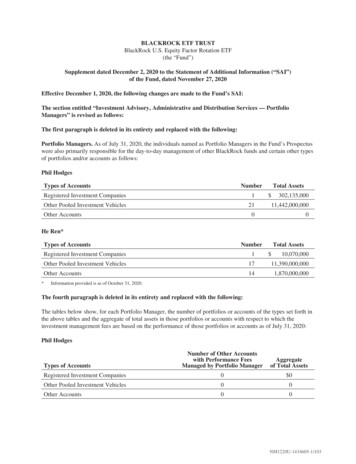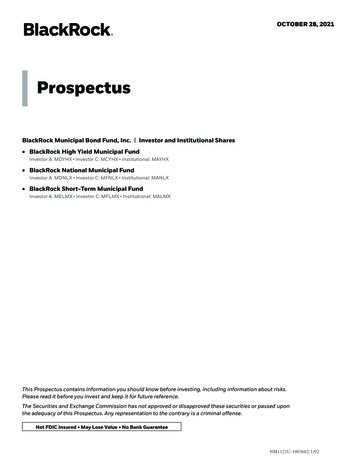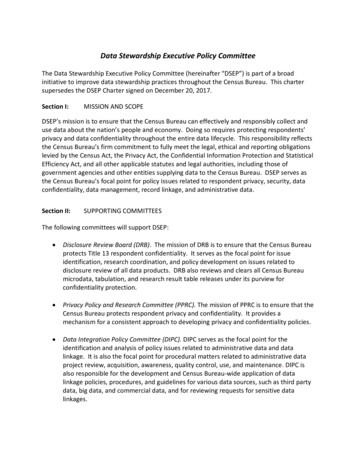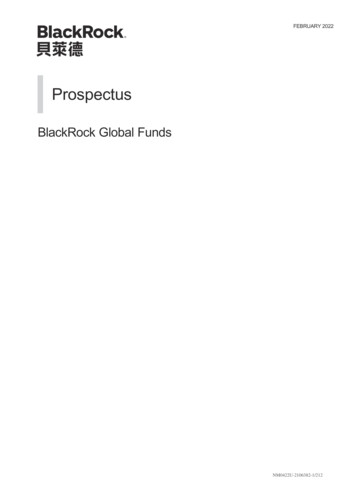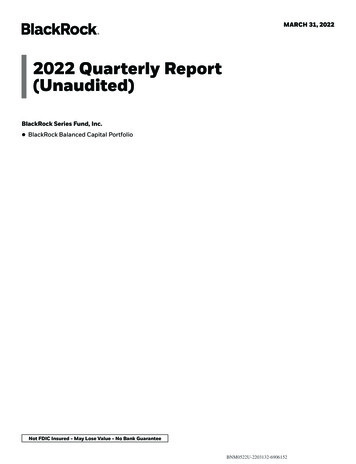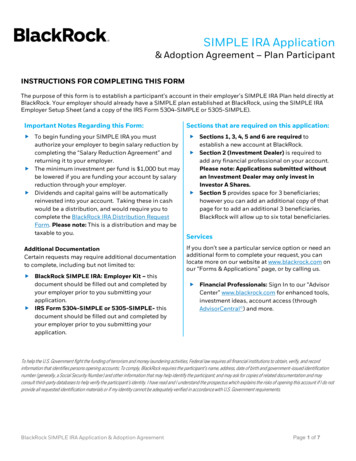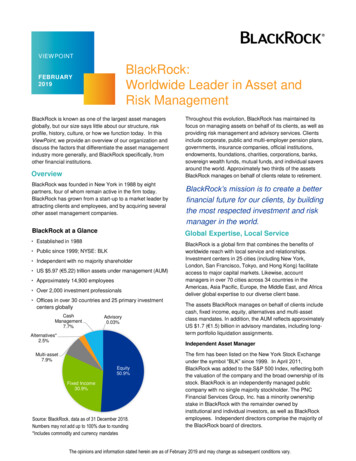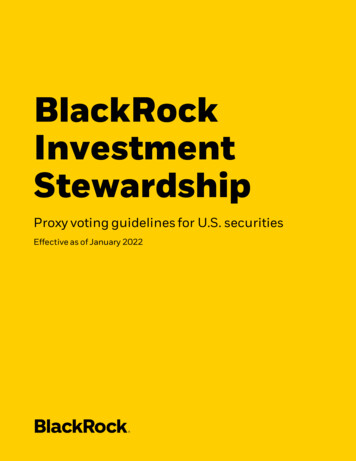
Transcription
BlackRockInvestmentStewardshipProxy voting guidelines for U.S. securitiesEffective as of January 2022
ContentsIntroduction.3Voting guidelines .3Boards and directors .3Auditors and audit-related issues . 11Capital structure proposals . 11Mergers, acquisitions, asset sales, and other special transactions . 12Executive compensation . 13Environmental and social issues. 16General corporate governance matters . 19Shareholder protections. 20BlackRock Investment StewardshipProxy voting guidelines for U.S. securities 2
These guidelines should be read in conjunction with the BlackRock Investment Stewardship GlobalPrinciples.IntroductionWe believe BlackRock has a responsibility to monitor and provide feedback to companies, in our role asstewards of our clients’ investments. BlackRock Investment Stewardship (“BIS”) does this throughengagement with management teams and/or board members on material business issues, includingenvironmental, social, and governance (“ESG”) matters and, for those clients who have given us authority,through voting proxies in the best long-term economic interests of their assets.The following issue-specific proxy voting guidelines (the “Guidelines”) are intended to summarize BIS’regional philosophy and approach to engagement and voting on ESG factors, as well as our expectationsof directors, for U.S. securities. These Guidelines are not intended to limit the analysis of individual issuesat specific companies or provide a guide to how BIS will engage and/or vote in every instance. They areapplied with discretion, taking into consideration the range of issues and facts specific to the company,as well as individual ballot items at annual and special meetings.Voting guidelinesThese guidelines are divided into eight key themes, which group together the issues that frequentlyappear on the agenda of annual and extraordinary meetings of shareholders: Boards and directors Auditors and audit-related issues Capital structure Mergers, acquisitions, asset sales, and other special transactions Executive compensation Environmental and social issues General corporate governance matters Shareholder protectionsBoards and directorsThe effective performance of the board is critical to the economic success of the company and theprotection of shareholders’ interests. As part of their responsibilities, board members owe fiduciary dutiesto shareholders in overseeing the strategic direction, operations, and risk management of the company.For this reason, BIS sees engagement with and the election of directors as one of our most criticalresponsibilities.Disclosure of material issues that affect the company’s long-term strategy and value creation, includingmaterial ESG factors, is essential for shareholders to appropriately understand and assess how effectivelythe board is identifying, managing, and mitigating risks.BlackRock Investment StewardshipProxy voting guidelines for U.S. securities 3
Where we conclude that a board has failed to address or disclose one or more material issues within aspecified timeframe, we may hold directors accountable or take other appropriate action in the context ofour voting decisions.Director electionsWhere a board has not adequately demonstrated, through actions and company disclosures, howmaterial issues are appropriately identified, managed, and overseen, we will consider voting against there-election of those directors responsible for the oversight of such issues, as indicated below.IndependenceWe expect a majority of the directors on the board to be independent. In addition, all members of keycommittees, including audit, compensation, and nominating/ governance committees, should beindependent. Our view of independence may vary from listing standards.Common impediments to independence may include: Employment as a senior executive by the company or a subsidiary within the past five years An equity ownership in the company in excess of 20% Having any other interest, business, or relationship (professional or personal) which could, or couldreasonably be perceived to, materially interfere with the director’s ability to act in the best interests ofthe companyWe may vote against directors serving on key committees who we do not consider to be independent,including at controlled companies.OversightWe expect the board to exercise appropriate oversight of management and the business activities of thecompany. Where we believe a board has failed to exercise sufficient oversight, we may vote against theresponsible committees and/or individual directors. The following illustrates common circumstances: With regard to material ESG risk factors, or where the company has failed to provide shareholderswith adequate disclosure to conclude appropriate strategic consideration is given to these factors bythe board, we may vote against directors of the responsible committee, or the most relevant director With regard to accounting practices or audit oversight, e.g., where the board has failed to facilitatequality, independent auditing. If substantial accounting irregularities suggest insufficient oversight,we will consider voting against the current audit committee, and any other members of the board whomay be responsible During a period in which executive compensation appears excessive relative to the performance ofthe company and compensation paid by peers, we may vote against the members of thecompensation committee Where a company has proposed an equity compensation plan that is not aligned with shareholders’interests, we may vote against the members of the compensation committee Where the board is not comprised of a majority of independent directors (this may not apply in thecase of a controlled company), we may vote against the chair of the nominating/governanceBlackRock Investment StewardshipProxy voting guidelines for U.S. securities 4
committee, or where no chair exists, the nominating/governance committee member with the longesttenure Where it appears the director has acted (at the company or at other companies) in a manner thatcompromises their ability to represent the best long-term economic interests of shareholders, wemay vote against that individual Where a director has a multi-year pattern of poor attendance at combined board and applicablecommittee meetings, or a director has poor attendance in a single year with no disclosed rationale, wemay vote against that individual. Excluding exigent circumstances, BIS generally considersattendance at less than 75% of the combined board and applicable committee meetings to be poorattendance Where a director serves on an excessive number of boards, which may limit their capacity to focus oneach board’s needs, we may vote against that individual. The following identifies the maximumnumber of boards on which a director may serve, before BIS considers them to be over-committed:Public Company Executive# Outside Public Boards 1Total # of Public Boards 1234Director ADirector B2Responsiveness to shareholdersWe expect a board to be engaged and responsive to its shareholders, including acknowledging votingoutcomes for director elections, compensation, shareholder proposals, and other ballot items. Where webelieve a board has not substantially addressed shareholder concerns, we may vote against theresponsible committees and/or individual directors. The following illustrates common circums tances: The independent chair or lead independent director, members of the nominating/governancecommittee, and/or the longest tenured director(s), where we observe a lack of board responsivenessto shareholders, evidence of board entrenchment, and/or failure to plan for adequate board membersuccession The chair of the nominating/governance committee, or where no chair exists, thenominating/governance committee member with the longest tenure, where board member(s) at themost recent election of directors have received against votes from more than 25% of shares voted,and the board has not taken appropriate action to respond to shareholder concerns. This may notapply in cases where BIS did not support the initial against vote1In addition to the company under review.Including fund managers whose full-time employment involves responsibility for the investment and oversight of fund vehicles,and those who have employment as professional investors and provide oversight for those holdings.2BlackRock Investment StewardshipProxy voting guidelines for U.S. securities 5
The independent chair or lead independent director and/or members of the nominating/governancecommittee, where a board fails to consider shareholder proposals that receive substantial support,and the proposals, in our view, have a material impact on the business, shareholder rights, or thepotential for long-term value creationShareholder rightsWe expect a board to act with integrity and to uphold governance best practices. Where we believe a boardhas not acted in the best interests of its shareholders, we may vote against the appropriate committeesand/or individual directors. The following illustrates common circumstances: The independent chair or lead independent director and members of the nominating/governancecommittee, where a board implements or renews a poison pill without shareholder approval The independent chair or lead independent director and members of the nominating/governancecommittee, where a board amends the charter/articles/bylaws and where the effect may be toentrench directors or to significantly reduce shareholder rights Members of the compensation committee where the company has repriced options withoutshareholder approvalIf a board maintains a classified structure, it is possible that the director(s) with whom we have aparticular concern may not be subject to election in the year that the concern arises. In such situations, ifwe have a concern regarding the actions of a committee and the responsible member(s), we will generallyregister our concern by voting against all available members of the relevant committee.Board composition and effectivenessWe encourage boards to periodically refresh their membership to ensure relevant skills and experiencewithin the boardroom. To this end, regular performance reviews and skills assessments should beconducted by the nominating/governance committee or the lead independent director. When nominatingnew directors to the board, we ask that there is sufficient information on the individual candidates sothat shareholders can assess the suitability of each individual nominee and the overall boardcomposition. Where boards find that age limits or term limits are the most efficient and objectivemechanism for ensuring periodic board refreshment, we generally defer to the board’s determination insetting such limits. BIS will also consider the average board tenure to evaluate processes for boardrenewal. We may oppose boards that appear to have an insufficient mix of short-, medium-, and longtenured directors.Furthermore, we expect boards to be comprised of a diverse selection of individuals who bring theirpersonal and professional experiences to bear in order to create a constructive debate of a variety of viewsand opinions in the boardroom. We are interested in diversity in the board room as a means to promotingdiversity of thought and avoiding “group think”. We ask boards to disclose how diversity is considered inboard composition, including demographic factors such as gender, race, ethnicity, and age; as well asprofessional characteristics, such as a director’s industry experience, specialist areas of expertise, andgeographic location. We assess a board’s diversity in the context of a company’s domicile, businessmodel, and strategy. We believe boards should aspire to 30% diversity of membership and encourageBlackRock Investment StewardshipProxy voting guidelines for U.S. securities 6
companies to have at least two directors on their board who identify as female and at least one whoidentifies as a member of an underrepresented group.3We ask that boards disclose: The aspects of diversity that the company believes are relevant to its business and how the diversitycharacteristics of the board, in aggregate, are aligned with a company’s long-term strategy andbusiness model The process by which candidates are identified and selected, including whether professional firms orother resources outside of incumbent directors’ networks have been engaged to identify and/orassess candidates, and whether a diverse slate of nominees is considered for all available boardnominations The process by which boards evaluate themselves and any significant outcomes of the evaluationprocess, without divulging inappropriate and/or sensitive detailsThis position is based on our view that diversity of perspective and thought – in the boardroom, in themanagement team, and throughout the company – leads to better long-term economic outcomes forcompanies. Academic research already reveals correlations between specific dimensions of diversity andeffects on decision-making processes and outcomes. 4 In our experience, greater diversity in theboardroom contributes to more robust discussions and more innovative and resilient decisions. Overtime, it can also promote greater diversity and resilience in the leadership team and workforce morebroadly, enabling companies to develop businesses that more closely reflect and resonate with thecustomers and communities they serve.To the extent that, based on our assessment of corporate disclosures, a company has not adequatelyaccounted for diversity in its board composition within a reasonable timeframe, we may vote againstmembers of the nominating/governance committee for an apparent lack of commitment to boardeffectiveness. We recognize that building high-quality, diverse boards can take time. We will look to thelargest companies (e.g., S&P 500) for continued leadership. Our publicly available commentary providesmore information on our approach to board diversity.Board sizeWe typically defer to the board in setting the appropriate size and believe directors are generally in thebest position to assess the optimal board size to ensure effectiveness. However, we may oppose boardsthat appear too small to allow for the necessary range of skills and experience or too large to functionefficiently.3Including, but not limited to, individuals who identify as Black or African American, Hispanic or Latinx, Asian, Native Ameri can orAlaska Native, or Native Hawaiian or Pacific Islander; individuals who identify as LGBTQ ; individuals who identify asunderrepresented based on national, Indigenous, religious, or cultural identity; individuals with disabilities; and veterans.4For example, the role of gender diversity on team cohesion and participative communication is explored by Post, C., 2015, When isfemale leadership an advantage? Coordination requirements, team cohesion, and team interaction norms , Journal of OrganizationalBehavior, 36, 1153-1175.BlackRock Investment StewardshipProxy voting guidelines for U.S. securities 7
CEO and management succession planningThere should be a robust CEO and senior management succession plan in place at the board level that isreviewed and updated on a regular basis. We expect succession planning to cover scenarios over both thelong-term, consistent with the strategic direction of the company and identified leadership needs overtime, as well as the short-term, in the event of an unanticipated executive departure. We encourage thecompany to explain its executive succession planning process, including where accountability lies withinthe boardroom for this task, without prematurely divulging sensitive information commonly associatedwith this exercise.Classified board of directors/staggered termsWe believe that directors should be re-elected annually; classification of the board generally limitsshareholders’ rights to regularly evaluate a board’s performance and select directors. While we willtypically support proposals requesting board de-classification, we may make exceptions, should theboard articulate an appropriate strategic rationale for a classified board structure. This may include whena company needs consistency and stability during a time of transition, e.g., newly public companies orcompanies undergoing a strategic restructuring. A classified board structure may also be justified at nonoperating companies, e.g., closed-end funds or business development companies (“BDC”),5 in certaincircumstances. We would, however, expect boards with a classified structure to periodically review therationale for such structure and consider when annual elections might be more appropriate.Without a voting mechanism to immediately address concerns about a specific director, we may chooseto vote against the directors up for election at the time (see “Shareholder rights” for additional detail).Contested director electionsThe details of contested elections, or proxy contests, are assessed on a case-by-case basis. We evaluate anumber of factors, which may include: the qualifications of the dissident and management candidates;the validity of the concerns identified by the dissident; the viability of both the dissident’s andmanagement’s plans; the ownership stake and holding period of the dissident; the likelihood that thedissident’s solutions will produce the desired change; and whether the dissident represents the bestoption for enhancing long-term shareholder value.Cumulative votingWe believe that a majority vote standard is in the best long-term interests of shareholders. It ensuresdirector accountability through the requirement to be elected by more than half of the votes cast. As such,we will generally oppose proposals requesting the adoption of cumulative voting, which maydisproportionately aggregate votes on certain issues or director candidates.Director compensation and equity programsWe believe that compensation for directors should be structured to attract and retain directors, while alsoaligning their interests with those of shareholders. We believe director compensation packages that are5A BDC is a special investment vehicle under the Investment Company Act of 1940 that is designed to facilitate capital formati on forsmall and middle-market companies.BlackRock Investment StewardshipProxy voting guidelines for U.S. securities 8
based on the company’s long-term value creation and include some form of long-term equitycompensation are more likely to meet this goal. In addition, we expect directors to build meaningful shareownership over time.Majority vote requirementsBIS believes that directors should generally be elected by a majority of the shares voted and will normallysupport proposals seeking to introduce bylaws requiring a majority vote standard for director elections.Majority vote standards assist in ensuring that directors who are not broadly supported by shareholdersare not elected to serve as their representatives. Some companies with a plurality voting standard haveadopted a resignation policy for directors who do not receive support from at l east a majority of votescast. Where we believe that the company already has a sufficiently robust majority voting process in place,we may not support a shareholder proposal seeking an alternative mechanism.We note that majority voting may not be appropriate in all circumstances, for example, in the context of acontested election, or for majority-controlled companies.Risk oversightCompanies should have an established process for identifying, monitoring, and managing business andmaterial ESG risks. Independent directors should have access to relevant management information andoutside advice, as appropriate, to ensure they can properly oversee risk. We encourage companies toprovide transparency around risk management, mitigation, and reporting to the board. We are particularlyinterested in understanding how risk oversight processes evolve in response to changes in corporatestrategy and/or shifts in the business and related risk environment. Comprehensive disclosure providesinvestors with a sense of the company’s long-term risk management practices and, more broadly, thequality of the board’s oversight. In the absence of robust disclosures, we may reasonably conclude thatcompanies are not adequately managing risk.Separation of chair and CEOWe believe that independent leadership is important in the boardroom. There are two commonly acceptedstructures for independent board leadership: 1) an independent chair; or 2) a lead independent directorwhen the roles of chair and CEO are combined.In the absence of a significant governance concern, we defer to boards to designate the most appropriateleadership structure to ensure adequate balance and independence.6In the event that the board chooses a combined chair/CEO model, we generally support the designationof a lead independent director if they have the power to: 1) provide formal input into board meetingagendas; 2) call meetings of the independent directors; and 3) preside at meetings of independentdirectors. Furthermore, while we anticipate that most directors will be elected annually, we believe an6To this end, we do not view shareholder proposals asking for the separation of chair and CEO to be a proxy for other concerns wemay have at the company for which a vote against directors would be more appropriate. Rather, support for such a proposal mig htarise in the case of overarching and sustained governance concerns such as lack of independence or failure to oversee a mater ialrisk over consecutive years.BlackRock Investment StewardshipProxy voting guidelines for U.S. securities 9
element of continuity is important for this role to provide appropriate leadership balance t o thechair/CEO.The following table illustrates examples of responsibilities under each board leadership model:Combined Chair/CEO ModelSeparate Chair ModelChair/CEOLead Independent DirectorChairAuthority to call full meetingsof the board of directorsAttends full meetings of theboard of directorsAuthority to call full meetingsof the board of directorsAuthority to call meetings ofindependent directorsBoard MeetingsBriefs CEO on issues arisingfrom executive sessionsAgendaBoardCommunicationsPrimary responsibility forshaping board agendas,consulting with the leadindependent directorCollaborates with chair/CEOto set board agenda and boardinformationPrimary responsibility forshaping board agendas, inconjunction with CEOCommunicates with alldirectors on key issues andconcerns outside of full boardmeetingsFacilitates discussion amongindependent directors on keyissues and concerns outside offull board meetings, includingcontributing to the oversightof CEO and managementsuccession planningFacilitates discussion amongindependent directors on keyissues and concerns outside offull board meetings, includingcontributing to the oversightof CEO and managementsuccession planningBlackRock Investment StewardshipProxy voting guidelines for U.S. securities 10
Auditors and audit-related issuesBIS recognizes the critical importance of financial statements to provide a complete and accurateportrayal of a company’s financial condition. Consistent with our approach to voting on directors, we seekto hold the audit committee of the board responsible for overseeing the management of the auditfunction at a company. We may vote against the audit committee members where the board has failed tofacilitate quality, independent auditing. We look to public disclosures for insight into the scope of theaudit committee responsibilities, including an overview of audit committee processes, issues on the auditcommittee agenda, and key decisions taken by the audit committee. We take particular note of casesinvolving significant financial restatements or material weakness disclosures, and we expect timelydisclosure and remediation of accounting irregularities.The integrity of financial statements depends on the auditor effectively fulfilling its role. To that end, wefavor an independent auditor. In addition, to the extent that an auditor fails to reasonably identify andaddress issues that eventually lead to a significant financial restatement, or the audit firm has violatedstandards of practice, we may also vote against ratification.From time to time, shareholder proposals may be presented to promote auditor independence or therotation of audit firms. We may support these proposals when they are consistent with our views asdescribed above.Capital structure proposalsEqual voting rightsBIS believes that shareholders should be entitled to voting rights in proportio n to their economicinterests. We believe that companies that look to add or that already have dual or multiple class sharestructures should review these structures on a regular basis, or as company circumstances change.Companies with multiple share classes should receive shareholder approval of their capital structure on aperiodic basis via a management proposal on the company’s proxy. The proposal should give unaffiliatedshareholders the opportunity to affirm the current structure or establish mechanisms to end or phase outcontrolling structures at the appropriate time, while minimizing costs to shareholders.Blank check preferred stockWe frequently oppose proposals requesting authorization of a class of preferred stock with unspecifiedvoting, conversion, dividend distribution, and other rights (“blank check” preferred stock) because theymay serve as a transfer of authority from shareholders to the board and as a possible entrenchmentdevice. We generally view the board’s discretion to establish voting rights on a when-issued basis as apotential anti-takeover device, as it affords the board the ability to place a block of stock with an investorsympathetic to management, thereby foiling a takeover bid without a shareholder vote.Nonetheless, we may support the proposal where the company: Appears to have a legitimate financing motive for requesting blank check authority Has committed publicly that blank check preferred shares will not be used for anti-takeover purposes Has a history of using blank check preferred stock for financingsBlackRock Investment StewardshipProxy voting guidelines for U.S. securities 11
Has blank check preferred stock previously outstanding such that an increase would not necessarilyprovide further anti-takeover protection but may provide greater financing flexibilityIncrease in authorized common sharesBIS will evaluate requests to increase authorized shares on a case-by-case basis, in conjunction withindustry-specific norms and potential dilution, as well as a company’s history with respect to the use of itscommon shares.Increase or issuance of preferred stockWe generally support proposals to increase or issue preferred stock in cases where the company specifiesthe voting, dividend, conversion, and other rights of such stock and where the terms of the preferred stockappear reasonable.Stock splitsWe generally support stock splits that are not likely to negatively affect the ability to trade shares or theeconomic value of a share. We generally support reverse stock splits that are designed to avoid delistingor to facilitate trading in the stock, where the reverse split will not have a negative impact on share value(e.g., one class is reduced while others remain at pre-split levels). In the event of a proposal for a reversesplit that would not proportionately reduce the company’s authorized stock, we apply the same analysiswe would use for a proposal to increase authorized stock.Mergers, acquisitions, asset sales, and other specialtransactionsIn assessing mergers, acquisitions, asset sales, or other special transactions – including businesscombinations involving Special Purpose Acquisition Companies (“SPACs”) – BIS’ primary consideration isthe long-term economic interests of our clients as shareholders. We expect boards proposing atransaction to clearly explain the economic and strategic rationale behind it. We will review a proposedtransaction to determine the degree to which it enhances long-term shareholder value. While mergers,acquisitions, asset sales, business combinations, and other special transaction proposals vary widely inscope and substance, we closely examine certain salient features in our analyses, such as: The degree to which the proposed transaction represents a premium to the company’s trading price.We consider the share price over multiple time periods prior to the date of the merger announcement.We may consider comparable transaction analyses provided by the parties’ financial advisors and ourown valuation assessments. For companies facing insolvency or bankruptcy, a premium may notapply There should be clear strategic, operational, and/or financial rationale for the combination Unanimous board approval and arm’s-length negotiations are preferred. We will consider whether thetransaction involves a dissenting board or does no
We believe that independent leadership is important in the boardroom. There are two commonly accepted structures for independent board leadership: 1) an independent chairman; or 2) a lead independent director when the roles of chairman and CEO are combined.
